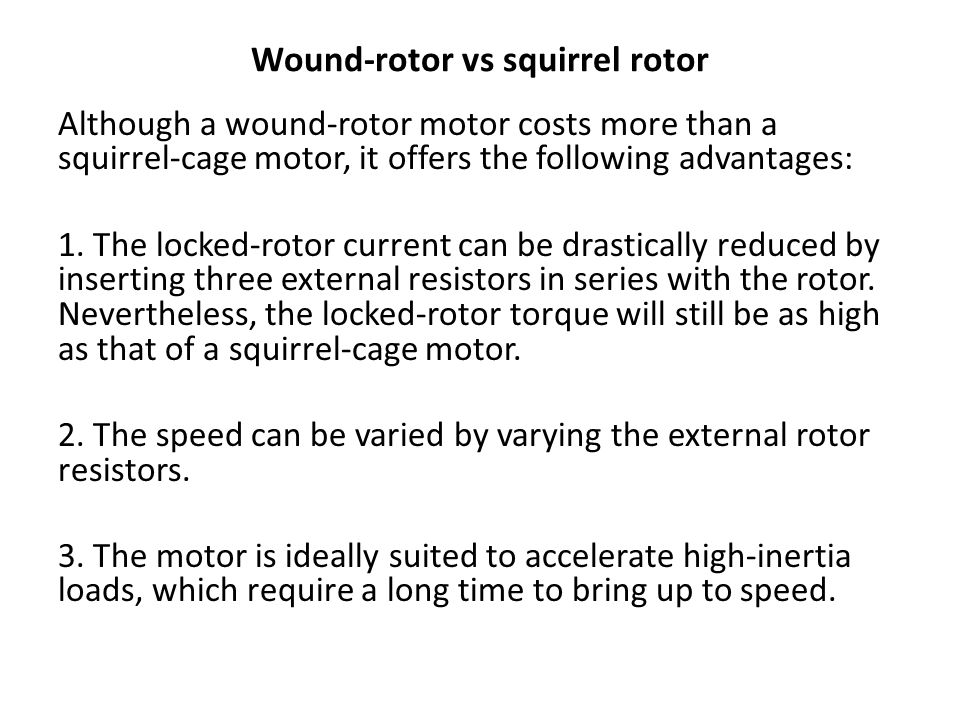Difference Between Squirrel Cage And Wound Rotor Induction Motor Pdf

Both squirrel cage and wound-rotor, and induced current flows. • The difference between the motor speed and the synchronous speed is called the slip speed Where n slip = slip speed n sync. • Both induction motor and transformer works on the principle of induced voltage.
Schematic symbol of a slip ring motor A wound-rotor motor is a type of where the windings are connected through to external resistance. Adjusting the resistance allows control of the speed/torque characteristic of the motor. Wound-rotor motors can be started with low inrush current, by inserting high resistance into the rotor circuit; as the motor accelerates, the resistance can be decreased. Compared to a, the rotor of the slip ring motor has more winding turns; the induced voltage is then higher, and the current lower, than for a squirrel-cage rotor.
During the start-up a typical rotor has 3 poles connected to the slip ring. Each pole is wired in series with a variable power resistor. When the motor reaches full speed the rotor poles are switched to short circuit. During start-up the resistors reduce the field strength at the stator.
As a result the is reduced. Another important advantage over squirrel-cage motors is higher starting torque. The construction of slip ring induction motor is quite different compared to other induction motor. Slip rings Induction motor provides some advantages like provides high starting torque, low starting current and it improves the power factor. We can add external variable resistance to the rotor of this type of motor.
So, we are able to control the speed of this type of motor easily. A wound-rotor motor can be used in several forms of. Certain types of variable-speed drives recover slip-frequency power from the rotor circuit and feed it back to the supply, allowing wide speed range with high energy efficiency.
Use the slip rings to supply external power to the rotor circuit, allowing wide-range speed control. Today speed control by use of slip ring motor is mostly superseded by induction motors with. References [ ].
Table of Contents • • • • • • • Fig.1 Squirrel Cage rotor • In Squirrel cage induction motors the rotor is simplest and most rugged in construction. • Cylindrical laminated core rotor with heavy bars of copper or Aluminum is used for conductors. • Rotor conductors or rotor bars are short-circuited with end rings. • Rotor bars are permanently short-circuited and hence it is not possible to connect an external resistance in the circuit in series with the rotor conductors. • It has low cost. Download free unlv uptown 4 life rar online. • There are no moving contacts in the rotor.
• Higher efficiency. • Low starting torque. It has 1.5-time full load torque.
• Speed control by rotor resistance is not possible. • Starting current is 5 to 7 times the full load current.
What are the advantages of skewing of rotor conductors in Squirrel cage induction motor? Skewing is the tilting of rotor conductor bars as shown in Fig.1. The advantages of skewing are as follows • There is a production of uniform torque. Due to this noise during operation reduces. • The magnetic locking tendency of the rotor reduces.
During locking process, the stator and rotor teeth attract each other due to magnetic action. This locking process is called as Cogging.
To avoid magnetic locking due to cogging, thats why conductors are skewed. Note: Number of Poles and phases develop automatically in cage rotor and equal to number of Poles and phases as in stator. This means that rotor responds automatically for the change in stator poles.